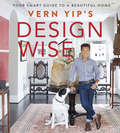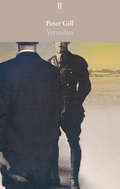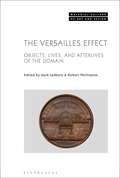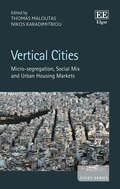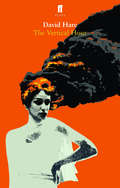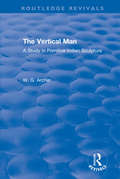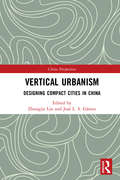- Table View
- List View
Vermessungskunde (Handbibliothek für Bauingenieure #4 )
by Martin Näbauer Robert OtzenDieser Buchtitel ist Teil des Digitalisierungsprojekts Springer Book Archives mit Publikationen, die seit den Anfängen des Verlags von 1842 erschienen sind. Der Verlag stellt mit diesem Archiv Quellen für die historische wie auch die disziplingeschichtliche Forschung zur Verfügung, die jeweils im historischen Kontext betrachtet werden müssen. Dieser Titel erschien in der Zeit vor 1945 und wird daher in seiner zeittypischen politisch-ideologischen Ausrichtung vom Verlag nicht beworben.
Vermessungskunde 1: Lage-, Höhen- und Winkelmessungen
by Volker MatthewsDas bewährte Lehrbuch erklärt die Grundlagen der Vermessung. So zum Beispiel die vermessungstechnische Überprüfung und die Absteckung von Bauwerken, die geometrische Prüfung und Überwachung der Bauausführung nach Lage und Höhe während der Bauphase und nach Fertigstellung. Die beschriebenen Arbeitsabläufe sind ebenso Grundlage der Bauaufnahme, die als Umkehrung des vermessungstechnischen Arbeitens beim Bauen angesehen werden kann. Im vorliegenden Teil 1 werden Anwendung und Prüfung der Rollbandmasse für die Längenmessung, der analogen und digitalen Nivellierinstrumente für die Höhenmessung sowie der analogen und digitalen Theodolite eingehend besprochen. Geräte zur elektronischen Streckenmessung, digitale Tachymeter und Computertachymeter werden in Teil 2 behandelt.
Vern Yip's Design Wise: Your Smart Guide to a Beautiful Home
by Vern YipHGTV and Trading Spaces' trusted interior designer Vern Yip shares his favorite design secrets to creating living spaces that have flow, balance, and harmony--while opening his doors to show how he's made these principles work in his own beloved homes. This New York Times bestseller provides both the inspiration and the clear, essential guidelines you need to create a home that perfectly reflects you. Have you ever wondered exactly how high to hang your artwork? How about the light fixture over your dining table? Do you know how to ideally size a rug for any room, or the best way to arrange your furniture? Beloved designer Vern Yip answers these questions, and more, by revealing the right formulas and measurements that can make any room feel just "right." And once you know these key design principles, you're free to confidently create a home that uniquely celebrates your needs and style. With gorgeous photos throughout, Vern Yip's Design Wise is a book you'll return to again and again.
Vernacular America: Architectural Studies from Winterthur Portfolio
by The University of Chicago PressFor many students, vernacular architecture represents a novel approach to the study of the built environment. Even after several decades of intellectual embrace, many professors of art and architectural history continue to find it difficult to integrate vernacular architecture into a course syllabus. Instructors face a daunting task: how can a more expansive, nuanced picture of the history of the American built environment be taught when standard textbooks continue to privilege the same monuments decade after decade without acknowledging the richness of the American architectural legacy? Vernacular America, selected from three decades of Winterthur Portfolio articles on the subject, addresses that problem by suggesting practical strategies for balancing, and perhaps even undermining, the canon of American architecture as it is taught in many college classrooms. Many instructors of New World architectural history seek to bring broad social, ethnic, political, and technical perspectives to the study of the built environment. While they await a survey book that fully integrates academic and vernacular narratives, the articles in this course reader are intended to encourage instructors and students to incorporate a diverse and inclusive approach into the curriculum, one that continues to understand the past, but also one that pays attention to the future. The aim of this publication is to offer both instructors and students the opportunity to create and nurture a more comprehensive picture of the history of the built environment of the United States. Barbara Burlison Mooney is associate professor of art history at the University of Iowa. Professor Mooney’s area of specialization encompasses both American architecture and African American art.
Vernacular Architecture and Regional Design
by Kingston HeathSustainable design requires that design practitioners respond to a particular set of social, cultural and environmental conditions. 'Vernacular Architecture and Regional Design' defines a set of strategies for understanding the complexities of a regional setting. Through a series of international case studies, it examines how architects and designers have applied a variety of tactics to achieve culturally and environmentally appropriate design solutions. • Shows that architecture and design are inextricably linked to social and environmental processes, and are not just technical or aesthetic exercises.• Articulates a variety of methods to realise goals of socially responsible and environmentally responsive design.• Calls for a principled approach to design in an effort to preserve fragile environments and forge sustainable best practice. 'Vernacular Architecture and Regional Design' will appeal to educators and professional practitioners in the fields of architecture, heritage conservation and urban design. Dr. Kingston Wm. Heath is Professor and Director of the Historic Preservation Program at the University of Oregon. Previously he was Professor of Architecture at the University of North Carolina, Charlotte where he taught seminars on vernacular architecture and regional design theory. He holds graduate degrees from the University of Chicago and Brown University. In addition to numerous articles in scholarly journals, he is the author of Patina of Place, and winner of the Abbott Lowell Cummings Award from The Vernacular Architecture Forum for excellence in a scholarly work. He has earned an international reputation in the field of vernacular architecture and has directed field schools in Italy and Croatia.
Vernacular Architecture and Regional Design
by Kingston HeathSustainable design requires that design practitioners respond to a particular set of social, cultural and environmental conditions. 'Vernacular Architecture and Regional Design' defines a set of strategies for understanding the complexities of a regional setting. Through a series of international case studies, it examines how architects and designers have applied a variety of tactics to achieve culturally and environmentally appropriate design solutions. • Shows that architecture and design are inextricably linked to social and environmental processes, and are not just technical or aesthetic exercises.• Articulates a variety of methods to realise goals of socially responsible and environmentally responsive design.• Calls for a principled approach to design in an effort to preserve fragile environments and forge sustainable best practice. 'Vernacular Architecture and Regional Design' will appeal to educators and professional practitioners in the fields of architecture, heritage conservation and urban design. Dr. Kingston Wm. Heath is Professor and Director of the Historic Preservation Program at the University of Oregon. Previously he was Professor of Architecture at the University of North Carolina, Charlotte where he taught seminars on vernacular architecture and regional design theory. He holds graduate degrees from the University of Chicago and Brown University. In addition to numerous articles in scholarly journals, he is the author of Patina of Place, and winner of the Abbott Lowell Cummings Award from The Vernacular Architecture Forum for excellence in a scholarly work. He has earned an international reputation in the field of vernacular architecture and has directed field schools in Italy and Croatia.
Vernacular Architecture in the 21st Century: Theory, Education and Practice
by Lindsay Asquith Marcel VellingaThe issues surrounding the function and meaning of vernacular architecture in the twenty-first century are complex and extensive. Taking a distinctively rigorous theoretical approach, this book considers these issues from a number of perspectives, broadening current debate to a wider multidisciplinary audience. These collected essays from the leading experts in the field focus on theory, education and practice in this essential sector of architecture, and help to formulate solutions to the environmental, disaster management and housing challenges facing the global community today.
Vernacular Architecture in the 21st Century: Theory, Education and Practice
by Lindsay Asquith Marcel VellingaThe issues surrounding the function and meaning of vernacular architecture in the twenty-first century are complex and extensive. Taking a distinctively rigorous theoretical approach, this book considers these issues from a number of perspectives, broadening current debate to a wider multidisciplinary audience. These collected essays from the leading experts in the field focus on theory, education and practice in this essential sector of architecture, and help to formulate solutions to the environmental, disaster management and housing challenges facing the global community today.
Vernacular Buildings: A Global Survey (International Library Of Human Geography Ser.)
by Allen NobleThe face of the world is changing and nowhere is this more evident than with vernacular buildings. They disappear or are extensively changed for a variety of reasons, from natural causes such as fire, storm and earthquake, to a wide variety ofcultural causes including obsolescence and changes in fashion, function and lifestyle. All of these factors, subtle and not so subtle, work to alter the material culture of our planet. But change and constancy are two fundamental qualities of vernacular buildings and dwellings. Constancy permits the evolution of types and characteristics to be identified, even in widely spread locations. It helps trace the origins of structures, despite later modifications. And change allows one to trace the effects of difference in environment, fashion, cultural ideas and economic influences. Change and constancyoperate together, although one or other may dominate at a particular time and place. In Vernacular Buildings Allen Noble extends the global survey contained in his earlier highly successful Traditional Buildings, to cover vernacular buildings and dwellings around the world. In a truly comprehensive account, he ranges from the farmsteads of pioneer Braziliansettlers, the Masai dwellings of Tanzania and the gothic houses of Shanghai, to Virginia Hall and Parlor houses, the thatched dwellings of the Eifel region of Germany and the three-decker houses of New York. Acknowledging the value of archival research the author is also firmly convinced of the importance of field observation and the book isextensively illustrated with photographs from his own personal collection. With a comprehensive bibliography, and incorporating new material from cultural geographers, historians, folklorists and anthropologists, Vernacular Buildings is a unique survey that will be welcomed by specialists and enthusiasts alike.
Vernetzt-kooperative Planungsprozesse im Konstruktiven Ingenieurbau: Grundlagen, Methoden, Anwendungen und Perspektiven zur vernetzten Ingenieurkooperation
by Uwe RüppelPlanungsprozesse im Bauwesen sind arbeitsteilig: verschiedene Fachplaner an verteilten Standorten, die unterschiedlichen Organisationen angehören. Die Praxis bietet Beispiele für unzählige Mängel, die auf unzureichende Kooperation zurückzuführen sind. In diesem Buch: aktuelle Forschungsergebnisse, Hinweise zur Umsetzung, Trends. Zur besseren computergestützten Überwachung und Steuerung der Planungsprozesse, und Vermeidung kostenintensiver Fehler.
Vernissage im privaten Wohnraum: Temporäre Ausstellungskonzepte zeitgenössischer Kunst
by Simone LarischSimone Larisch liefert die erste zusammenfassende Darstellung von Ausstellungsformaten, die temporär zeitgenössische bildende Kunst im privaten Wohnraum zeigen. Analysiert werden neben den Konzepten und Strategien der privaten Kunstvermittler auch Motive von Gastgebern, Ausstellungsmachern, Künstlern und Besuchern. Die Untersuchung aktueller Fallbeispiele und der Vorgängerprojekte heutiger Ausstellungen im privaten Wohnraum, also der „Urväter“, „Prototypen“ und „nahen Verwandten“, führt im Ergebnis nicht nur zu Erkenntnissen über diese Ausstellungssparte, sondern auch zu vielen erstaunlichen Kunstgeschichten.
The Vernor's Story: From Gnomes to Now
by Lawrence L. RouchAmply illustrated, The Vernor's Story -- From Gnomes to Now captures the spirit and genius of the people who transformed Vernors into an iconic American soft drink that has spanned two centuries of shifting public taste. With over seventy photographs depicting the history of the company, The Vernor's Story is an insider's look at early operations, as well as the firm's famous marketing blitz, featuring Vernor's distinctive green and gold packaging and its engaging gnome. Add to that the legion of devoted Vernor's fans, and the beverage itself, a unique, spicy, mysteriously flavored carbonated ginger drink that's appealed to generations of Michiganders and others alike, and you have the makings of a great American success story. A treasure on its own and sure to be a future collectible, this is a fascinating slice of Americana for Vernor's fans everywhere. Lawrence Rouch is President of Studio3/Innovations, a marketing and consulting firm representing fine artists in the automotive and fine-arts fields.
Versailles
by Peter GillIn the drawing room of the Rawlinson's late Victorian villa in Kent, life as it was lived before the war is quietly resuming.The family's son, Leonard Rawlinson, is among the British delegation sent to Versailles to draw up the treaty that will come to define Europe, the Middle East and the rest of the world. With the ghost of a fallen loved one still haunting him, Leonard perceives that the choices made in Paris will shape the fate of millions for centuries to come. Versailles premiered at the Donmar Warehouse, London, in February 2014.
Versailles (The Landmark Library #11)
by Colin JonesFew buildings carry such a freight of historical symbolism as the Palace of Versailles. First built as a hunting lodge by Louis XIII in the early seventeenth century, then radically repurposed by his absolutist son Louis XIV, Versailles became the focus of that king's centralised power. Drawing on a new wave of research in recent years, particularly on the buildings and material culture of Versailles, Colin Jones, distinguished historian of early modern France, describes the various building campaigns undertaken by Louis XIV and his formal installation of his court at Versailles in 1682; the ritualized rhythms of life at the court of the Sun King; the palace's variegated fortunes under Revolution, First Empire, Restoration and July Monarchy; its return to the political stage in the Franco-Prussian War; its later role as a venue for treaty signings and proclamations; and its continuing legacy as imposing physical embodiment of the ancien régime.
The Versailles Effect: Objects, Lives, and Afterlives of the Domaine (Material Culture of Art and Design)
by Mark Ledbury and Robert WellingtonThe essays in this volume show that Versailles was not the static creation of one man, but a hugely complex cultural space; a centre of power, but also of life, love, anxiety, creation, and an enduring palimpsest of aspirations, desires, and ruptures. The splendour of the Château and the masterpieces of art and design that it contains mask a more complex and sometimes more sordid history of human struggle and achievement. The case studies presented by the contributors to this book cannot provide a comprehensive account of the Palace of Versailles and its domains, the life within its walls, its visitors, and the art and architecture that it has inspired from the seventeenth century to the present day: from the palace of the Sun King to the Penthouse of Donald Trump. However, this innovative collection will reshape-or even radically redefine-our understanding of the palace of Versailles and its posterity.
The Versailles Effect: Objects, Lives, and Afterlives of the Domaine (Material Culture of Art and Design)
The essays in this volume show that Versailles was not the static creation of one man, but a hugely complex cultural space; a centre of power, but also of life, love, anxiety, creation, and an enduring palimpsest of aspirations, desires, and ruptures. The splendour of the Château and the masterpieces of art and design that it contains mask a more complex and sometimes more sordid history of human struggle and achievement. The case studies presented by the contributors to this book cannot provide a comprehensive account of the Palace of Versailles and its domains, the life within its walls, its visitors, and the art and architecture that it has inspired from the seventeenth century to the present day: from the palace of the Sun King to the Penthouse of Donald Trump. However, this innovative collection will reshape-or even radically redefine-our understanding of the palace of Versailles and its posterity.
Verschwörungsideologien in Filmen und Serien: Erklärungsansätze und Chancen zur Intervention
by Denis Newiak Anastasia SchnitzerCorona als inszeniertes Unterdrückungsinstrument, geheim gehaltene Impftote oder kinderbluttrinkende Politiker: Spätestens seit dem Ausbruch der Covid-19-Pandemie haben Verschwörungsideologien Hochkonjunktur und schaden durch ihren Dogmatismus dem sozialen Frieden und der demokratischen Willensbildung. Sogenannte Verschwörungstheorien (conspiracy theories) erzeugen systematisches Misstrauen gegenüber den legitimierten politischen Institutionen und können zu gesellschaftlicher Polarisierung, gefährlichem Populismus und extremistischer Eskalierung beitragen. In Kinofilmen und Fernsehserien waren Verschwörungsideologien schon immer Thema, setzen sie sich doch durch ihre filmischen Mittel seit jeher mit der Beziehung zwischen Realität und Illusion, Wahrheit und Fiktion, Wirklichkeit und Traum, Sinn und Wahnsinn auseinander. Serien und Filme dienen dabei nicht nur als Diskursraum gesellschaftlicher Selbstverständigung, sondern unterbreiten auch durch ihre komplexen Narrative, Figurenkonstellationen und Ästhetiken eingängige Erklärungsansätze für das Entstehen und die Verbreitung von Verschwörungserzählungen. Zugleich unterbreiten sie dabei zum Teil erstaunlich konkrete Vorschläge zur Handhabung solcher kollektiver Wahnvorstellungen. Was können wir aus den fiktionalen Welten von Serien und Filmen für den Umgang mit diesem ganz realen Gegenwartsphänomen lernen?
Vertical Cities: Micro-segregation, Social Mix and Urban Housing Markets (Cities series)
Exploring the social implications of dense and compact cities, this enlightening book looks at micro-scale segregation through several lenses. These include the ways that the housing market constantly reconfigures social mix, how the structure of the housing stock shapes it, and the ways that policies are deployed to manage these effects. Taking a deep dive into micro-segregation in the socially mixed and dense centres of compact cities, the authors investigate the form and content of social and ethno-racial hierarchies at the micro-scale of different cities around the world and the ways these have evolved over time. Vertical Cities considers the ways the materiality of such hierarchies affects the reproduction of social inequalities in today’s large cities. Academics and researchers of urban sociology, housing, urban regeneration, urban studies and urban geography will find the original approach taken to this under-researched topic to be a vital resource. Practitioners and policy makers will find the innovative use of a common theoretical frame to analyse micro-scale social mix in vertical/compact cities informative when dealing with the management of neighbourhoods in inner cities.
The Vertical Hour: A Play
by David HareNadia Blye is a young American war reporter turned academic who teaches Political Studies at Yale. A brief holiday with her boyfriend brings her into contact with a kind of Englishman whose culture and background is a surprise and a challenge, both to her and to her relationship. For thirty five years, David Hare has written plays which catch the flavour of our times, the interconnection between our secret motives and our public politics. Now, at last, he writes about an American, seeking to illustrate how life has subtly changed for so many people in the West in the new century.The Vertical Hour received its world premiere at the Music Box Theater, Broadway, on November 30, 2006, and received its UK premiere at the Royal Court Theatre, London, on 17 January 2008.
The Vertical Man: A Study in Primitive Indian Sculpture (Routledge Revivals)
by W.G. ArcherOriginally published in 1947, The Vertical Man explores a form of Indian sculpture largely ignored in other studies, with a focus on two kinds of sculpture from the province of Bihar. The book provides detailed analysis of the formal characteristics of the sculpture and the influences of the myth, ritual, and context in which they were commissioned and made. It explains why the sculpture is regional and "why the styles are what they are". It is an original study which throws light on important subjects such as the relations of art and religion and of art and economics. The Vertical Man will appeal to those with an interest in art, specifically sculpture and the art of the Indian countryside.
The Vertical Man: A Study in Primitive Indian Sculpture (Routledge Revivals)
by W.G. ArcherOriginally published in 1947, The Vertical Man explores a form of Indian sculpture largely ignored in other studies, with a focus on two kinds of sculpture from the province of Bihar. The book provides detailed analysis of the formal characteristics of the sculpture and the influences of the myth, ritual, and context in which they were commissioned and made. It explains why the sculpture is regional and "why the styles are what they are". It is an original study which throws light on important subjects such as the relations of art and religion and of art and economics. The Vertical Man will appeal to those with an interest in art, specifically sculpture and the art of the Indian countryside.
Vertical Urbanism: Designing Compact Cities in China (China Perspectives)
by Zhongjie Lin José L. S. GámezStudies of compact cities have evolved along with the rising awareness of climate change and sustainable development. Relevant debates, however, reveal that the prevailing definitions and practices of compact cities are tied primarily to traditional Western urban forms. This book reinterprets "compact city", and develops a ground-breaking discourse of "Vertical Urbanism", a concept that has never been critically articulated. It emphasizes "Vertical Urbanism" as a dynamic design strategy instead of a static form, distinguishing it from the stereotyped concept of "vertical city" or "towers in the park" dominant in China and elsewhere, and suggests its adaptability to different geographic and cultural contexts. Using Chinese cities as laboratories of investigation, this book explores the design, ecological, and sociocultural dimensions of building compact cities, and addresses important global urban issues through localized design solutions, such as the relationship between density and vitality, the integration of horizontal and vertical dimensions of design, and the ecological and social adaptability of combinatory mega-forms. In addition, through discussions with scholars from the United States, China, and Japan, this book provides an insight into the theoretical debates surrounding "compact city" and "Vertical Urbanism" in the global context. Scholars and students in architecture and urban planning will be attracted by this book. Also, it will appeal to readers with an interest in urban development and Asian studies.
Vertical Urbanism: Designing Compact Cities in China (China Perspectives)
by Zhongjie Lin José L. S. GámezStudies of compact cities have evolved along with the rising awareness of climate change and sustainable development. Relevant debates, however, reveal that the prevailing definitions and practices of compact cities are tied primarily to traditional Western urban forms. This book reinterprets "compact city", and develops a ground-breaking discourse of "Vertical Urbanism", a concept that has never been critically articulated. It emphasizes "Vertical Urbanism" as a dynamic design strategy instead of a static form, distinguishing it from the stereotyped concept of "vertical city" or "towers in the park" dominant in China and elsewhere, and suggests its adaptability to different geographic and cultural contexts. Using Chinese cities as laboratories of investigation, this book explores the design, ecological, and sociocultural dimensions of building compact cities, and addresses important global urban issues through localized design solutions, such as the relationship between density and vitality, the integration of horizontal and vertical dimensions of design, and the ecological and social adaptability of combinatory mega-forms. In addition, through discussions with scholars from the United States, China, and Japan, this book provides an insight into the theoretical debates surrounding "compact city" and "Vertical Urbanism" in the global context. Scholars and students in architecture and urban planning will be attracted by this book. Also, it will appeal to readers with an interest in urban development and Asian studies.
Vertigo (BFI Film Classics)
by Charles BarrVertigo (1958) is widely regarded as not only one of Hitchcock's best films, but one of the greatest films of world cinema. Made at the time when the old studio system was breaking up, it functions both as an embodiment of the supremely seductive visual pleasures that 'classical Hollywood' could offer and – with the help of an elaborate plot twist – as a laying bare of their dangerous dark side. The film's core is a study in romantic obsession, as James Stewart's Scottie pursues Madeleine/Judy (Kim Novak) to her death in a remote Californian mission. Novak is ice cool but vulnerable, Stewart – in the darkest role of his career – genial on the surface but damaged within. Although it can be seen as Hitchcock's most personal film, Charles Barr argues that, like Citizen Kane, Vertigo is at the same time a triumph not so much of individual authorship as of creative collaboration. He highlights the crucial role of screenwriters Alec Coppel and Samuel Taylor and, by a combination of textual and contextual analysis, explores the reasons why Vertigo continues to inspire such fascination. In his foreword to this special edition, published to celebrate the 20th anniversary of the BFI Film Classics series, Barr looks afresh at Vertigo alongside the recently-rediscovered 'lost' silent The White Shadow (1924), scripted by Hitchcock, which also features the trope of the double, and at the acclaimed contemporary silent film The Artist (2011), which pays explicit homage to Vertigo in its soundtrack.


